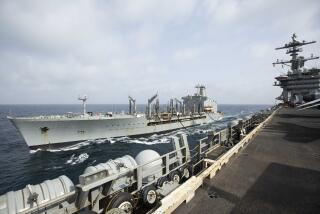Bad maintenance, delayed evacuation doomed 9 in amphibious vehicle sinking, report says
- Share via
SAN DIEGO — The sinking of a Marine amphibious vehicle off the San Diego coast in July, killing nine service members, was the result of failed maintenance and human errors, including a delay in evacuating troops until 45 minutes after water first started leaking into the vehicle.
The full investigation has not been released, but the Marines released a summary Thursday afternoon.
In addition to the poor material condition of the vehicle and the lengthy delay before its commander ordered 15 others on board to evacuate, military news site USNI News reported the troops had not been given a safety brief before the day’s operation and hadn’t been trained in waterborne evacuation procedures.
Eight Marines and one sailor were killed. They ranged in age from 18 to 23. Seven Marines survived.
Assault amphibious vehicles entered service in the Marine Corps in 1972. The vehicle that sank was 35 years old, Military.com reported. Several of the vehicles operating that day from 3rd Amphibian Assault Battalion had maintenance and performance issues.
The vehicles deploy from the well decks of Navy amphibious ships and ferry Marines to shore. Once on land, the tracked and armored vehicles transport troops to and from battlefields before returning to their ships. They can carry up to 21 troops and are operated by a crew of three.
On July 30, the Marines of Battalion Landing Team 1/4 were training with the 15th Marine Expeditionary Unit off the San Diego coast near San Clemente Island. The island is frequently used for amphibious training and is the home of a Navy SEAL training area and the Navy’s only ship-to-shore firing range.
That morning, 13 amphibious vehicles left the amphibious transport dock USS Somerset to train on San Clemente Island, about three miles away from the ship, according to the Marine Corps summary of the investigation. A 14th vehicle had to stay aboard the ship because of maintenance problems, reports say.
The Marines were supposed to return to the ship from the island at noon but were delayed when another vehicle broke down. While on the island, the crew of the vehicle that later sank also performed maintenance on their vehicle, reports say.
Four vehicles stayed behind on the island and nine departed for the Somerset about 5 p.m. Shortly after leaving the island, two of the nine turned back and returned to the island because of their own problems.
The vehicle that eventually sank also began having mechanical issues. First, its transmission failed. Then, its water drive, which helps propel the vehicle, failed. Water began coming into the vehicle through its engine compartment plenums and a leaking headlight. The vehicle’s generator also failed, leaving the Marines and sailor on board in the dark.
The loss of its transmission also affected the operation of the vehicle’s bilge pumps, the Marines said. That meant they could not expel water as fast as the vehicle was taking it on.
Water entered the crew compartment up to the troops’ ankles but the commander didn’t order them evacuate as required. As the water continued to rise, he rose out of his hatch and frantically waved a distress flag. Twenty minutes passed before another Marine amphibious vehicle saw it. There was no safety boat in the water as required — it was still on board the Somerset.
By the time another vehicle made it to the floundering AAV, 45 minutes had passed since it first began taking on water. Most of the troops inside were still wearing heavy body armor. The vehicle commander ordered the troops to open a side hatch, drop their equipment and evacuate. But it was dark inside the vehicle and the troops struggled to open the hatch. Some used the lights on their cellphones. Some reportedly began to panic. The water was as high as the benches inside.
After the troops managed to open a hatch on the top of their vehicle, the rescue vehicle collided with it, sending it broadside into a wave. The wave washed into the troop compartment via the open hatch and the vehicle rapidly sank with 11 still on board. Two were recovered alive. It took five days for a remote-operated Navy submarine to find the vehicle and the remains of the men.
After the tragedy, the Marines suspended all waterborne operations of its decades-old AAV fleet. In October, Lt. Col Michael Regner, the commanding officer of the battalion landing team, was fired. This week, Col. Christopher Bronzi, the commanding officer of the 15th Marine Expeditionary Unit, was relieved of command after the completion of the Marines’ investigation.
Seven additional personnel whose failures contributed to the incident also received administrative or disciplinary action, the Marines said.
Dyer writes for the San Diego Union-Tribune.
More to Read
Sign up for Essential California
The most important California stories and recommendations in your inbox every morning.
You may occasionally receive promotional content from the Los Angeles Times.











